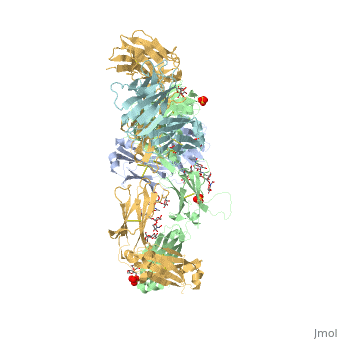Keytruda
From Proteopedia
(Difference between revisions)
| Line 12: | Line 12: | ||
===PD-L1/PD-1 Interaction=== | ===PD-L1/PD-1 Interaction=== | ||
The complex formed when protein-derived ligand, PD-L1, interacts with the inhibitory receptor, PD-1, suppresses immune responses against autoantigens and helps in peripheral immune tolerance. However, when tumors over express PD-L1, the interaction with PD-1 inhibits T-lymphocyte proliferation, release of cytokines, and cytotoxicity, exhausting tumor-specific T-cells. There are a total of 12 PD-1<sub>ECD</sub> residues that are involved in forming the complex with the N-terminal half of PD-1<sub>ECD</sub> (PD-1<sub>ECD-N</sub>). Nine hydrogen bonds, 3 water-mediated hydrogen bonds, 2 salt bridges, and numerous hydrophobic interactions make up the PD-1<sub>ECD</sub>/PD-1<sub>ECD-N</sub> interaction. The CC’FG sheet within both proteins is the main interaction point. A hydrophobic surface patch is formed when the PD-1<sub>ECD</sub> is in complex with PD-L1<sub>ECD-N</sub>. The PD-1<sub>ECD</sub> residues involved include Val64, Tyr68, Ile126, Leu128, Ala132 and Ile134. Numerous [http://www.nature.com/articles/srep35297/figures/1 Hydrophilic amino acids] that encircle PD-L1<sub>ECD-N</sub> form salt bridges and hydrogen bonds with Asn66, Tyr68, Gln75, Thr76, Asp77, Lys78, Ala132 and Glu136 of PD-1<sub>ECD</sub> <ref name="horita" />. | The complex formed when protein-derived ligand, PD-L1, interacts with the inhibitory receptor, PD-1, suppresses immune responses against autoantigens and helps in peripheral immune tolerance. However, when tumors over express PD-L1, the interaction with PD-1 inhibits T-lymphocyte proliferation, release of cytokines, and cytotoxicity, exhausting tumor-specific T-cells. There are a total of 12 PD-1<sub>ECD</sub> residues that are involved in forming the complex with the N-terminal half of PD-1<sub>ECD</sub> (PD-1<sub>ECD-N</sub>). Nine hydrogen bonds, 3 water-mediated hydrogen bonds, 2 salt bridges, and numerous hydrophobic interactions make up the PD-1<sub>ECD</sub>/PD-1<sub>ECD-N</sub> interaction. The CC’FG sheet within both proteins is the main interaction point. A hydrophobic surface patch is formed when the PD-1<sub>ECD</sub> is in complex with PD-L1<sub>ECD-N</sub>. The PD-1<sub>ECD</sub> residues involved include Val64, Tyr68, Ile126, Leu128, Ala132 and Ile134. Numerous [http://www.nature.com/articles/srep35297/figures/1 Hydrophilic amino acids] that encircle PD-L1<sub>ECD-N</sub> form salt bridges and hydrogen bonds with Asn66, Tyr68, Gln75, Thr76, Asp77, Lys78, Ala132 and Glu136 of PD-1<sub>ECD</sub> <ref name="horita" />. | ||
| - | == Disease in Humans | + | == Disease in Humans == |
T-cells are a major component of the immune response in the human body. They have the ability to recognize cancer-related antigens as non-self and eliminate those cells <ref>doi 10.2147/DDDT.S78036</ref>. PD-L1 and PD-L2 are ligands expressed by some tumors and inhibit T-cell function when bound to PD-1, which is located on the surface of antigen-specific T-cells <ref>doi 10.1007/s40265-016-0543-x</ref>. When PD-L1 is ligated to PD-1 an adaptive immune response occurs, and this allows cancer cells to bypass immune surveillance and grow uncontrollably. Pembrolizumab is an FDA-approved treatment that works as a PD-1 pathway inhibitor to fight numerous forms of cancer, such as metastatic melanoma and non-small cell lung cancer. As an inhibitor, Pembrolizumab targets the cell death of PD-1 and blocks the immune checkpoint pathway. Pembrolizumab has a very high affinity to PD-1, allowing it to block the interaction between PD-1 with PD-L1 and PD-L2 very efficiently. It antagonizes the interaction between PD-1 and its known ligands, and re-activates anti-tumor immunity <ref name="log" />. The PD-1/PD-L1 interaction inhibits T-lymphocyte proliferation, releases cytokines and cytotoxicity, and exhausts tumor-specific T-cells. The inhibition of this pathway reverses the exhausted t-cell phenotype and normalizes the anti-tumor response. One downside of Pembrolizumab is that it may cause inflammatory side effects <ref name="horita" />. | T-cells are a major component of the immune response in the human body. They have the ability to recognize cancer-related antigens as non-self and eliminate those cells <ref>doi 10.2147/DDDT.S78036</ref>. PD-L1 and PD-L2 are ligands expressed by some tumors and inhibit T-cell function when bound to PD-1, which is located on the surface of antigen-specific T-cells <ref>doi 10.1007/s40265-016-0543-x</ref>. When PD-L1 is ligated to PD-1 an adaptive immune response occurs, and this allows cancer cells to bypass immune surveillance and grow uncontrollably. Pembrolizumab is an FDA-approved treatment that works as a PD-1 pathway inhibitor to fight numerous forms of cancer, such as metastatic melanoma and non-small cell lung cancer. As an inhibitor, Pembrolizumab targets the cell death of PD-1 and blocks the immune checkpoint pathway. Pembrolizumab has a very high affinity to PD-1, allowing it to block the interaction between PD-1 with PD-L1 and PD-L2 very efficiently. It antagonizes the interaction between PD-1 and its known ligands, and re-activates anti-tumor immunity <ref name="log" />. The PD-1/PD-L1 interaction inhibits T-lymphocyte proliferation, releases cytokines and cytotoxicity, and exhausts tumor-specific T-cells. The inhibition of this pathway reverses the exhausted t-cell phenotype and normalizes the anti-tumor response. One downside of Pembrolizumab is that it may cause inflammatory side effects <ref name="horita" />. | ||
Revision as of 23:45, 5 December 2016
Pembrolizumab antibody against programmed cell death-1 receptor
| |||||||||||
References
- ↑ 1.0 1.1 Longoria TC, Tewari KS. Evaluation of the pharmacokinetics and metabolism of pembrolizumab in the treatment of melanoma. Expert Opin Drug Metab Toxicol. 2016 Oct;12(10):1247-53. doi:, 10.1080/17425255.2016.1216976. Epub 2016 Aug 16. PMID:27485741 doi:http://dx.doi.org/10.1080/17425255.2016.1216976
- ↑ 2.0 2.1 2.2 2.3 Horita S, Nomura Y, Sato Y, Shimamura T, Iwata S, Nomura N. High-resolution crystal structure of the therapeutic antibody pembrolizumab bound to the human PD-1. Sci Rep. 2016 Oct 13;6:35297. doi: 10.1038/srep35297. PMID:27734966 doi:http://dx.doi.org/10.1038/srep35297
- ↑ Rajakulendran T, Adam DN. Spotlight on pembrolizumab in the treatment of advanced melanoma. Drug Des Devel Ther. 2015 Jun 4;9:2883-6. doi: 10.2147/DDDT.S78036. eCollection, 2015. PMID:26082618 doi:http://dx.doi.org/10.2147/DDDT.S78036
- ↑ Deeks ED. Pembrolizumab: A Review in Advanced Melanoma. Drugs. 2016 Mar;76(3):375-86. doi: 10.1007/s40265-016-0543-x. PMID:26846323 doi:http://dx.doi.org/10.1007/s40265-016-0543-x

